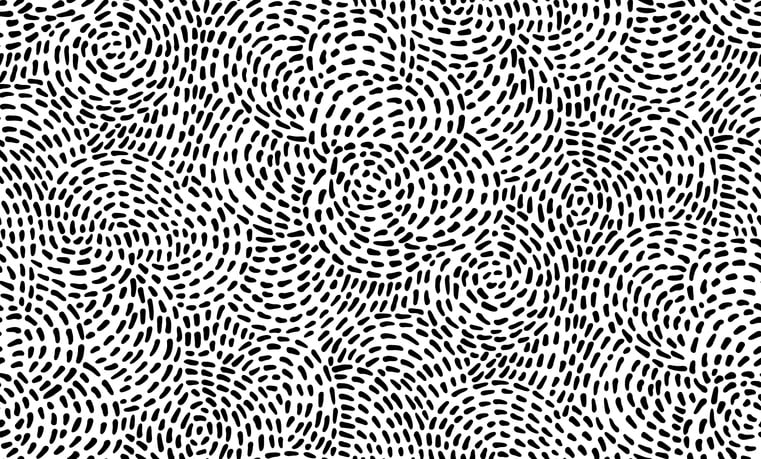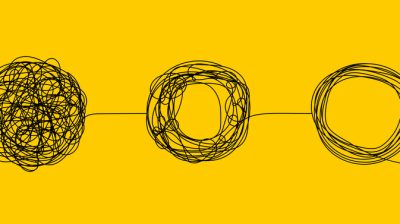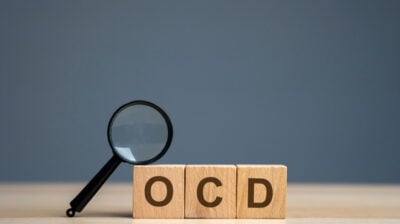I’m having intrusive thoughts. Do I have OCD?
Find out more about the signs and symptoms of OCD.

If you think you or someone close to you might have symptoms of obsessive-compulsive disorder (OCD), you might have questions such as:
How are obsessions defined?
Can you explain the meaning of a ‘compulsion’?
What are the 5 most common types of intrusive thoughts?
How do I know if I have OCD?
What causes OCD?
What causes OCD to get worse?
This factsheet offers information to answer these questions on the common signs and symptoms of OCD. You can find more information on diagnosis and treatment, as well as accessing supports in our factsheets on how OCD is diagnosed and how to manage symptoms of OCD.
What is Obsessive Compulsive Disorder (OCD)?
The understanding of mental health conditions has changed over time and psychiatrists have made changes to how they define obsessive compulsive disorder. The Diagnostic and Statistical Manual of Mental Disorders, Fifth Edition (DSM-5) is a guide that mental health professionals use worldwide to identify and diagnose mental health conditions. While previous versions of the DSM categorised OCD as an anxiety disorder, today the DSM-5 defines OCD as one of a group of mental disorders known as ‘obsessive-compulsive and related disorders.’
People with OCD regularly experience obsessions, compulsions or a combination of both.
What are obsessions (intrusive thoughts)?
In general, obsessions are unwanted or intrusive thoughts, images or impulses that may come about spontaneously or in response to certain triggers. The type of obsessive thoughts varies from person to person. However, OCD intrusive thoughts are often on topics such as:
- Sex or religion
- Fear of contamination from touching objects others have touched
- Shaking hands
- Fear of harm to yourself or others
Avoidance of the activities or situations that tend to trigger obsessive thoughts is also common for people with OCD.
What are compulsions?
Compulsions are repetitive acts or rituals that a person with OCD feels they have to perform in response to obsessions. It is not something that they want to do for pleasure. Compulsions generally follow rigid rules that carry a special urgency or meaning. People often perform them in an effort to reduce the anxiety associated with the obsessions or achieve a sense of completion. Examples of compulsive behaviour include:
- Repetitive counting
- Checking
- Touching
- Washing
Some people receive an OCD diagnosis as adults. However, obsessive-compulsive symptoms generally first appear in children and young teens between the ages of eight and twelve. Research suggests that symptoms of OCD appear at a younger age for men than for women, with nearly 25 per cent of men developing symptoms before age 10 years. Children may have some difficulty recognising and describing their obsessions, while adults are generally aware of their obsessions and compulsions.
What are the 5 most common types of intrusive thoughts?
Researchers have found that OCD symptoms often focus on similar topics across different cultures and social groups. This has lead to the identification of five main themes of intrusive thoughts. Each theme is often associated with a particular type of compulsion or action.
These themes and their compulsions include:
- Contamination, which includes fears of germs, dirt, or infection. This is often linked to compulsions like washing or cleaning
- Harm-related thoughts, such as fear of causing harm to yourself or others. People with these thoughts may engage in checking behaviours to make sure nothing dangerous has happened
- Unacceptability, involves intrusive thoughts that may be aggressive, sexual, or religious. In response, people may perform mental rituals or pray
- Symmetry, where people may have excessive concerns about symmetry and order. These thoughts can lead to compulsions like straightening, repeating, and counting
- Hoarding, which involves the fear of getting rid of things. Hoarding behaviours can be part of the broader pattern of obsessions and compulsions typical of OCD. When they appear alone, however, they may be classified as a separate but related condition called hoarding disorder
Each of the above examples has connected particular themes with certain types of action or compulsion. However, they do not always work this way. For example, an obsessive thought about harm to others might trigger a compulsion to count, rather than a concern about how objects are ordered or arranged.
How do I know if I have OCD?
People experience OCD in different ways and this can make it challenging to create an OCD symptoms checklist. However, signs and symptoms of OCD in adults include:
- Obsessions and/or compulsions centred mainly around fear of contamination, fear of harming yourself or others
- Intrusive aggressive, sexual, or religious thoughts
- Concerns about symmetry and order
- Fear of throwing away items (hoarding)
Not all repetitive or unwanted thoughts are obsessions, and not all repetitive behaviours are compulsions.
For people with OCD:
- Obsessions and compulsions often take up more than an hour each day
- Obsessions usually cause significant distress, and both obsessions and compulsions can interfere with a person’s ability to work, socialise, and perform daily tasks
- Obsessive-compulsive symptoms are not due to another mental health condition or the effects of medication or substances
- Obsessions and compulsions are often involuntary and hard to control, even if the person is aware that they are excessive
OCD affects 1-2 per cent of adults, but recent research shows that 13-38 per cent of adults experience “subclinical” obsessive-compulsive symptoms, with even higher rates among young people. Subclinical obsessive-compulsive symptoms are often milder and shorter-lasting. They can still cause significant distress, but are not severe enough to qualify as diagnosable mental health conditions.
To find out if your symptoms meet the criteria for OCD or a related disorder, a professional will assess factors like the level of anxiety your symptoms cause and how much they interfere with your daily life.
What causes OCD?
You may be wondering what causes OCD to develop. While the precise causes of OCD remain unknown, research shows that there are a variety of risk factors that can increase the likelihood of developing OCD.
Childhood Trauma
Research suggests a link between a history of traumatic events, such as physical and sexual abuse in childhood, and a higher risk of developing OCD.
Childhood infection
When OCD develops quickly in children, it has been linked to the immune system mistakenly attacking the body’s own tissues following an infection. While these infections might increase the risk of developing OCD, they are unlikely to directly cause OCD in children.
Genes
Besides environmental factors, genes also play a role in OCD. Genes are parts of our DNA that contain the instructions for how our bodies grow, develop, and function. Research shows that first-degree relatives (like parents or siblings) of adults with OCD are about twice as likely to have OCD compared to those without a family history. This risk increases ten times if the relative with OCD developed it in childhood or adolescence.
Brain changes
More and more researchers are asking the question: “How does OCD affect the brain?” Some studies have found differences in how certain brain regions function and communicate, which could explain symptoms of obsessive-compulsive disorder. In trying to form connections between a person’s OCD symptoms and specific brain differences, researchers are hoping to develop more effective OCD treatments.
What causes OCD to get worse?
A person’s obsessive compulsive symptoms can get worse due to things like stress, lack of sleep, exposure to a traumatic event, or the presence of a co-occurring mental health condition. For example, many individuals with OCD, especially those with contamination fears, saw their obsessions and compulsions worsen during the Covid-19 pandemic.
Research also suggests that hormonal changes during the menstrual cycle can affect the severity of a person’s obsessive compulsive symptoms. Some studies indicate that symptoms may worsen during pregnancy and in the 6 weeks following childbirth (‘postpartum period’), periods when ovarian hormones fluctuate greatly. Some people may also notice an increase in OCD symptoms during the premenstrual or late-luteal phase of their menstrual cycle. In one study involving 101 participants, nearly half of outpatients with OCD reported worsening symptoms during this phase.
Feeling overwhelmed and want to talk to someone?
- Get anonymous support 24/7 with our text message support service
- Connect with a trained volunteer who will listen to you, and help you to move forward feeling better
- Whatsapp us now or free-text SPUNOUT to 50808 to begin.
- Find out more about our text message support service
If you are a customer of the 48 or An Post network or cannot get through using the ‘50808’ short code please text HELLO to 086 1800 280 (standard message rates may apply). Some smaller networks do not support short codes like ‘50808’.






